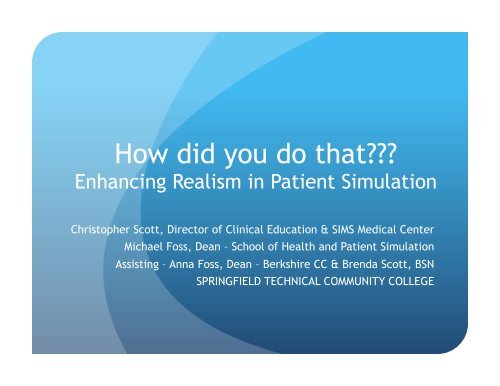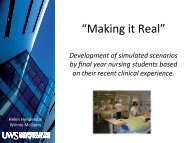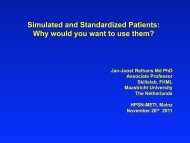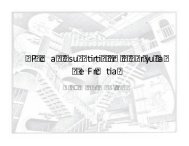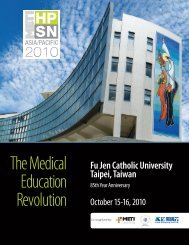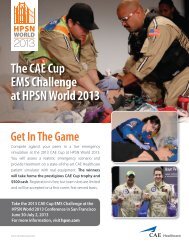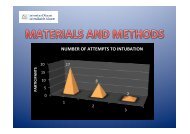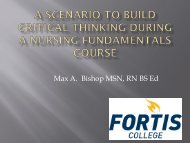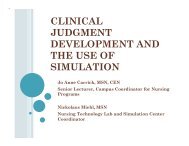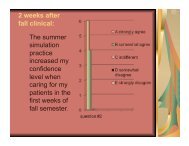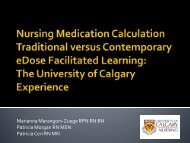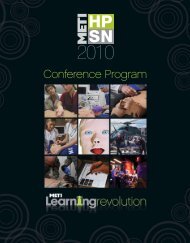PDF 1
PDF 1
PDF 1
You also want an ePaper? Increase the reach of your titles
YUMPU automatically turns print PDFs into web optimized ePapers that Google loves.
How did you do that<br />
Enhancing Realism in Patient Simulation<br />
Christopher Scott, Director of Clinical Education & SIMS Medical Center<br />
Michael Foss, Dean – School of Health and Patient Simulation<br />
Assisting – Anna Foss, Dean – Berkshire CC & Brenda Scott, BSN<br />
SPRINGFIELD TECHNICAL COMMUNITY COLLEGE
What is Realism<br />
Realism, Websterʼs way<br />
true and faithful portrayal of nature and of people in<br />
art and literature
What is Realistic<br />
REALITY- A MATTER OF PERCEPTION<br />
Thus the Instructor must have the ability to<br />
manipulate on the fly<br />
As long as participants perceive the environment and<br />
responses as plausible, then the simulation will<br />
remain intact
Factors that are Required for a<br />
Successful Realistic Simulation<br />
Plausible Environment<br />
Familiar Equipment<br />
Plausible Responses<br />
Realistic Simulation<br />
Equipment<br />
Plausible Interactions<br />
Seropian, M. Technology, Computing and Simulation (2003)<br />
Anesth Analg
Fidelity<br />
the quality or state of being faithful b: accuracy in<br />
details : exactness2: the degree to which an electronic<br />
device (as a record player, radio, or television)<br />
accurately reproduces its effect (as sound or picture)<br />
Three Important Fidelities of Patient Simulation<br />
Fidelity<br />
Fidelity<br />
Fidelity
Equipment Fidelity<br />
The degree to which the<br />
simulator duplicates the<br />
appearance and feel of the<br />
real system.<br />
Example: A simulator that<br />
realistically mimics the<br />
layout of an aircraft cockpit.<br />
Our Example: The Labor and<br />
Deliver Nurse walks into a<br />
simulation room that really<br />
looks like a maternity/<br />
birthing suite with realistic<br />
up to date equipment and a<br />
patient with functions that<br />
realistically meet the<br />
objectives.
Environmental Fidelity<br />
The extent to which the simulator duplicates motion<br />
cues, visual cues, and other sensory information from<br />
the task environment.<br />
Example: A flight simulator can be defined as high or low<br />
fidelity depending on whether or not the motion and video<br />
cues were turned on or off.<br />
Our Example – AN ER team walks into a simulation and<br />
while treating the patient, sounds like the C-Med Radio,<br />
overhead pages, and occasional PT Scream, and other<br />
noises/smells are occurring.
Psychological Fidelity<br />
<br />
<br />
<br />
<br />
<br />
Degree to which the trainee perceives the simulation to be a believable surrogate for<br />
the trained task or real patient encounter<br />
Allows learner to make conceptual sense of the scenario<br />
Generally considered to be the most essential requirement for team training<br />
Our Example – By having participants understand ahead of time the limitations<br />
of simulated patient experiences – aka orientation on the environment/patient –<br />
the students are able to successfully adapt (fiction contract) and work together<br />
to deliver realistic care and obtain quality learning experiences.<br />
Without suspending disbelief trainees are unlikely to behave in the simulation as<br />
they would in the real world! As a result, the training will have little or no<br />
application to the post-training environment.!!<br />
A Typology of simulation fidelity (adapted from Rehmann et al, 1995) #<br />
Beaubien, Baker. Quality and Safety in Health Care, 2004.
Fiction Contract<br />
Is a joint endeavor that students and the instructor/<br />
debriefer create:<br />
The instructor agrees to make the simulation as real as<br />
possible within the resource and technology constraints<br />
Participants agree to do their best to act as if everything is<br />
real. (Suspend Disbelief!)<br />
Instructor will state a fair and balanced assessment of<br />
simulator strengths and weaknesses<br />
AKA – Introduction to Simulator & the environment.
Skillful blending of the three modes of thinking about<br />
realism [environmental, equipment, and psychological]<br />
will allow our trainees to suspend disbelief, or to<br />
actively sign up for the fiction contract that this is a<br />
situation with real relevance for them.<br />
Rudolph et al. Sim Healthcare. 2(3):161-163, Fall 2007.
<br />
<br />
A successful scenario is<br />
not based on the realism of<br />
the simulation itself, but<br />
rather the alchemy of<br />
participants stepping into<br />
their roles, connecting with<br />
others in the scenario, and<br />
actively linking to their<br />
previous social, clinical, and<br />
psychological experience.<br />
Rudolph et al. Sim Healthcare. 2(3):161-163, Fall 2007.
How did you do that<br />
Examples of realism in Patient Cases
What Makes Realism<br />
Clothes<br />
<br />
<br />
<br />
Makeup<br />
<br />
<br />
<br />
<br />
<br />
Patient gowns<br />
Street clothes<br />
Sizes – Clothes & shoes<br />
Jaundice<br />
Rashes<br />
Burns<br />
Abrasions and contusions<br />
Diaphoresis<br />
Gender<br />
Wigs<br />
Female Parts<br />
Smells<br />
Feces<br />
Sweat<br />
Vomit<br />
Sounds<br />
C-Med Radios<br />
Phone Systems<br />
Paging Systems<br />
Environment<br />
Up to date equipment<br />
Properly stocked rooms
How do we develop realism<br />
tools/ideas
Designing Realism <br />
-‐ Background (ques6ons to ask) <br />
• It is important to understand the physiology that is going on<br />
• IE - Developing a wound<br />
– What is the age of the wound<br />
– What environment did the wound occur<br />
• In the field or in the OR<br />
– Do you need to bring in some dirt<br />
– Is the wound infected PUS<br />
– Do we need odors<br />
– Broken Bones Do the bones really bend that way<br />
– Do we needs sound Background noise<br />
– Do we actors
Designing Realism<br />
Develop your own R & D Program<br />
Beta Test Each new item<br />
Does it look real<br />
Does it smell real<br />
Will it withstand the scenario<br />
Will the participants recognize the item as it was intended<br />
to be<br />
Is it cost – Efficient<br />
Can I easily reproduce it
Examples of how we make<br />
realism happen<br />
What we use, what we try not to use, and how we make it<br />
happen!
Items We Use…<br />
Fiber Therapy
Items We Try to Avoid<br />
FOODS/ Products with Sugar!!!<br />
Why – MOLD!!!
If we use food, we use it<br />
externally only!!<br />
Favorites include<br />
Lemon juice & Parmesan Cheese<br />
Limburger Cheese<br />
Okra<br />
Jello / Pudding<br />
Any combo for Feces
Items We use on a daily basis<br />
Sponges<br />
Brushes<br />
Filter Pads<br />
Cutips<br />
Saran Wrap<br />
Rubber Cement !!!<br />
Washable Paints<br />
Powder Based Make ups<br />
Ben Nye Makeup/Wheels<br />
Glycerin<br />
Vaseline<br />
Corn Starch<br />
Metamucil<br />
Stage Blood & Scab Blood<br />
Fake Urine<br />
Liquid Latex (Used Less)
Base Layer<br />
It is important to place a base<br />
layer of protection onto the<br />
simulator to allow for moulage to<br />
be easily removed upon<br />
completion of the scenario(s).
SMELLS
Making “Schkin”
Making “Schkin”
Can we get a volunteer to<br />
make “Schkin”!
So How do we use the Schkin
SCHKIN!<br />
Place enough schkin to area where<br />
you will make injury and blend it<br />
into the the area on simman.
Applying color<br />
Apply necessary color from color<br />
wheels to make injury realistic
Compound Fractures<br />
Same as lacerations<br />
Impale bone<br />
Chicken<br />
Rib<br />
Cotton<br />
Ben Nye Blood<br />
Rubber bands<br />
Coffee stirrers
Gun Shot Wound<br />
Apply schkin<br />
Make a divot in the skin to<br />
represent a bullet hole.<br />
Optional: Place eraser head in<br />
wound to mimic bullet.<br />
Apply ash around area if GSW was at<br />
close range<br />
Use pourable stage blood out of<br />
GSW Wound.
GSW Entrance Wound
GSW Exit Wound
Impalement<br />
Build up Schkin and mold into area<br />
Apply color wheel<br />
Insert impalement into schkin<br />
Apply stage blood as appropriate
Impalement
Road Rash/Abrasion<br />
Use filter sponge and apply color<br />
from color wheel to show road rash<br />
and abriasions
Seat Belt Bruising<br />
Use sponge and filter sponge to apply bruising color wheel in a pattern to<br />
represent an apparent bruise from a seatbelt.
Can we re-create or “mold”<br />
body parts to make<br />
simulations more realistic
Using Molds
How do you develop Sebaceous<br />
Cyst pads<br />
Cost Effective<br />
To purchase from company<br />
over $ 125.oo each<br />
Good only one time!<br />
Number needed for a<br />
single course<br />
At least 12 pads<br />
Answer<br />
Smooth – On<br />
Dragon Skin FX<br />
Able to quickly develop<br />
pads<br />
Cost Effective<br />
Cost Per Pad $ 25.00 for<br />
simman thigh pad and $<br />
18.00 per METI Pad
Products needed from Smooth On<br />
<br />
Able to purchase from local Reynolds AM distributors<br />
<br />
Items Needed:<br />
Mixing Buckets and Mixing Sticks<br />
<br />
<br />
<br />
Plexiglass<br />
Used to place the molded clay on to allow the smooth cast mold to be poured into and allow for release<br />
of the mold.<br />
Modeling Clay<br />
Used top build a reproduction of the moldable item to have smooth on poured into to make mold or<br />
used to allow for blood pockets to be made in the dragon skin product.<br />
SILC PIG Silicone Pigment<br />
<br />
<br />
Either 9 pack ( multi-color wheel) or flesh tone, blood, or brown)<br />
Fuse Fx Pro – Warm tan pigment<br />
Mann Release Ease 200<br />
<br />
<br />
Used to spray the clay to release the mold after pouring the smooth cast 300 into the clay shaped area<br />
that you want to make the reproduction of the item to be molded<br />
Use the spray on the clay that will be placed in the second layer of dragon skin to allow it to be<br />
released from the dragon skin to make the fillable blood area when the second layer dries.<br />
Dragon Skin FX Pro<br />
<br />
Mixed with the pigment to make the skin and tissue layers. No mann spray is needed to be used with<br />
the dragon skin unless clay is used.<br />
Smooth Cast 300<br />
<br />
Chemical mixed to make a mold of the item to be reproduced.
Mold Making
Spray the objects!! (with Mann Release)
Shaping of Mold
Removing the object
Building a sebaceous cyst and<br />
blood into the mold
Sebaceous Cyst Pads Completed
Abscess<br />
Can Be Incised<br />
Realistic Bleeding<br />
Can add: Pus, Blood, etc<br />
Easily Sutured<br />
Made by pouring dragon skin with pigment<br />
onto plexiglass sheet. When dry Cut into<br />
strips. Then pour clear dragon skin on a<br />
different plexiglass and cutting into<br />
squares when dry. Attach a square to the<br />
middle of the strip of skin using more<br />
dragon skin mixture and a second square<br />
place a small amount of dragon skin on the<br />
outside edges of all sides of the square and<br />
place on top of the same size square<br />
already attached to the skin, thus making a<br />
pocket. Once dry, Use a syringe filled with<br />
blood and slide needle into the pocket via<br />
the side and fill with blood, the pocket<br />
should self seal.
Abscesses
Filling Abscess Packets
Molding of body parts
Alja Safe<br />
Purpose: to make an identical mold of an item, such as<br />
body part<br />
Pros: Cheap, identical match of item<br />
Cons: single to double use only<br />
Items Needed:<br />
Equal parts Alja Safe (from smooth on) to warm water<br />
Mixing stick<br />
Item to be molded<br />
Item to house mold ( what you will make the mold in
Using Alja Safe
Re-creating molded item<br />
Once molded item is removed inspect the mold.<br />
Decide what the color of the item is you want to make<br />
the identical mold out of<br />
Use appropriate amount of dragon skin equal parts A &<br />
B with selected color mixed into part B of the dragon<br />
skin from the silc pig<br />
Once thoroughly mixed, pour mixture into mold and let<br />
sit for the appropriate cure time ( usually one hour)<br />
Gently remove molded item from the mold.
Suture Pads
Items needed for Suture Pads<br />
Piece of plywood<br />
Textured vinyl fabric (to make skin like texture)<br />
Glue gun (to adhere vinyl to plywood)<br />
Pressure Clamps<br />
Eco flex 00-30 (available from smooth – on)<br />
Eco flex Gel (available from smooth – on)<br />
Power Mesh (available from smooth – on)<br />
Silc Pig ( for Coloring) (available from smooth – on)
Making of the suture pads<br />
<br />
<br />
<br />
<br />
<br />
<br />
<br />
<br />
<br />
First adhere the vinyl to the plywood with glue<br />
Clamp power mesh to the vinyl board<br />
Mix equal parts of ecoflex 00-30 with the silc pig flesh color and stipple into mesh in a<br />
square area<br />
Let dry x 1 hour<br />
Mix equal parts of Ecoflex Gel with yellow color from silc pag and pour on top of skin<br />
layer, creating fat layer that is more gelatinous.<br />
let dry x 1 hour<br />
Mix equal part of eco – flex 00-30 with blood/muscle color from silc pig and pour on top<br />
of yellow layer<br />
Let dry x 1 hour<br />
Remove item and cut to shape.
Wound Making
Other inexpensive items to make
Broken Glass (the safe way)
Broken Glass (part two)
Ooze!! ( AKA drainage, mucous)
Intestines
Making Feces<br />
Vaseline, Cornstarch, Brown Paint
Molding Feces
Making Diarrhea
Making Diarrhea
Other great Realism<br />
Examples
Frostbite<br />
Use black eye shadow<br />
Fade in with white<br />
Jimmy Rowland
Partial Thickness Burn
Partial Thickness Burn<br />
Red saran wrap<br />
Liquid latex or Schkin<br />
Burn Color wheel<br />
Glycerin or Vaseline for shine
Examples of Burns/Blisters<br />
Apply liquid latex from Ben Nye to<br />
an area where you would like a<br />
burn/blister to appear.<br />
Let Air Dry to a dry/tacky<br />
consistency
Designing of Burn<br />
Once to a dry/slightly tacky<br />
consistency, use cue tip to pull<br />
areas of the liquid latex apart to<br />
make appearance of burn/sliding<br />
skin.
Apply blood from color wheel and ash/charcoal to<br />
wound, cover with petroleum Jelly
Making Maggot Foot
Maggot Foot
Cleaning Supplies
Ben Nye Kit
Resources <br />
www.cert-‐la.com/educa/on/moulage-‐recipes.pdf <br />
www.behindthesimcurtain.com <br />
www.whatcomcountyems.com/pdfs/CE%20Instructors/BASIC<br />
%20MOULAGE.pdf <br />
www.moulageconcepts.com <br />
www.sickkitchen.com <br />
MOLD Making – Dragon Skin <br />
www.smooth-‐on.com <br />
www.reynoldsam.com
Some Examples <br />
Just some examples of what you can do <br />
hHp://www.shopanatomical.com/<br />
Casualty_Simula6on_Moulage_s/14234.htm <br />
www.moulage.net <br />
www.prankpalace.com <br />
hHp://www.stagemakeuponline.com/ <br />
www.pocketnurse.com <br />
www.wallcur.com


